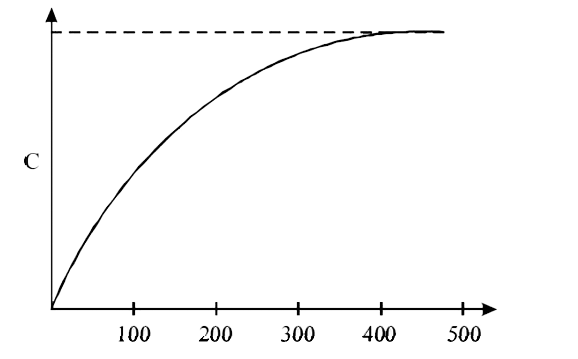The figure below shows the variation of specific heat capacity (C) of a solid as a function of temperature (T). The temperature is increased continuously form 0 to 500K at a constant rate. Ignoring any volume change, the following statement (s) is (are) correct to a reasonable approximation.
 Solution in Gujrati
Solution in Gujrati
The rate at which heat is absorbed in the range 0−100K varies linearly with temperature T.
Heat absorbed in increasing the temperature from 0−100K is less than the heat required for increasing the temperature from 400−500K.
There is no change in the rate of heat absorption in the range 400−500K
The rate of heat absorption increases in the range 200−300K
The correct Answer is:A, B, C, D
(A) From 0to100k the major part of graph lies in linear region and very small part in non-linear region, therefore to a reasonable approximation between 0K−100K, graph of C vs Tis linear.
_E01_422_S01.png)
(B) by comparing area under curve
_E01_422_S02.png)
(C) from 400Kto500K , Graph of C vs T become asymptotic hence rate of heat absorption become constant
(D) The rate of heat absorption increases as C is increasing.
Topper's Solved these Questions
- GEOMETRICAL OPTICSBOOK - ALLEN CHAPTER - GEOMETRICAL OPTICSEXERCISE - EXERCISE - 05 (B) (MATCH THE COLUMN)
3 Videos
- GEOMETRICAL OPTICSBOOK - ALLEN CHAPTER - GEOMETRICAL OPTICSEXERCISE - EXERCISE - 05 (B) (ASSERTION & REASON )
9 Videos
- GEOMETRICAL OPTICSBOOK - ALLEN CHAPTER - GEOMETRICAL OPTICSEXERCISE - EXERCISE - 05 (B)
58 Videos
- CURRENT ELECTRICITYBOOK - ALLEN CHAPTER - CURRENT ELECTRICITYEXERCISE - EX.II
66 Videos
- GRAVITATIONBOOK - ALLEN CHAPTER - GRAVITATIONEXERCISE - EXERCISE 4
9 Videos
Similar Questions
For the given process :-
_E01_426_Q01.png)
Column-IColumn-II(A)Process J→K(P)W>0(B)Process K→L(q)W<0(C)Process L→M(r)Q>0(D)Process M→J(s)Q<0
View SolutionStatement-1: The total translational kinetic energy of fall the molecules of a given mass of an ideal gas is 1.5 times the product of its pressure and its volume because.
Statement-2: The molecules of a gas collide with each other and the velocities of the molecules change due to the collision.
View SolutionA vessel contains a mixture of one mole of oxygen and two moles of nitrogen at 300K. The ratio of the average rorational kinetic energy per O2 molecules to that per N2 molecules is
View SolutionIn the Bohr's model of hy drogen atom, the electron moves around the nucleus in a circular orbit of radius 5×10−11m. Its time period is 1.5×10−16s. The current associated with the electron motion is:-
View SolutionAssertion : The difference in the value of acceleration due to gravity at pole and equator is proportional to square of angular velocity of earth.
Reason : the value of acceleration due to gravity is minimum at the equator and maximum at the pole.
View SolutionThe figure below shows the variation of specific heat capacity (C) of a solid as a function of temperature (T). The temperature is increased continuousely form 0 to 500K at a constant rate. Ignorign any volume change, the following statement (s) is (are) correct to a reasonable approximation.

View SolutionPlots showing the variation of the rate constant (k) with temperature (T) are given below. The plot that follows the Arrhenius equation is
View SolutionThe specific heat of solids at low temperatures varies with absolute temperature T according to the relation S=AT3, where A is a constant. The heat energy required to raise the temperature of a mass m of such a solid from T=0 to T=20K is:
View SolutionAssertion : A solid is floating in a liquid . If temperature is increased and expansion of solid is ignored, then fraction of volume immersed will increase. Reason : By increasing the temperature density of liquid will decrease.
View SolutionPlots showing the variation of the rate constant (k) with temperature (T) are given below. The plot that follows the Arrhenius equation is
View SolutionPlots showing the variation of the rate constant (k) with temperature (T) are given below. The plot that follows Arrhenius equations is
View SolutionPlots showing the variation of the rate constant (k) with temperature (T) are given below. The plot that follows the Arrhenius equation is
View SolutionThe ratio of specific heat capacity at constant pressure to the specific heat capacity at constant volume of a diatomic gas decreases with increases in temperature . Explain
View Solutionचित्र में किसी ठोस की विशिष्ट उष्माधारिता (C ) का तापमान (T) पर निर्भरता को दर्शाया गया है | तापमान में 0 से 500 केल्विन तक समान दर से सतत वृद्धि होती है | यह मानकर कि आयतन में परिवर्तन उपेक्षणीय है, निम्न प्रकथन में कौन - सा (से) तर्कसंगत सन्निकट सही है (हैं) ?

View SolutionFor a body of mass m and specific heat capacity s, how much heat is required to increase its temperature by t?
View SolutionThe figure shows the variation of specific heat capacity (c) of a solid as a function of temperature (T). The temperature is increased continuously from 0 to 500 K at constant rate. ignoring any volume change, the following statement(s) is (are) correct to reasonable approximation.
View Solution
